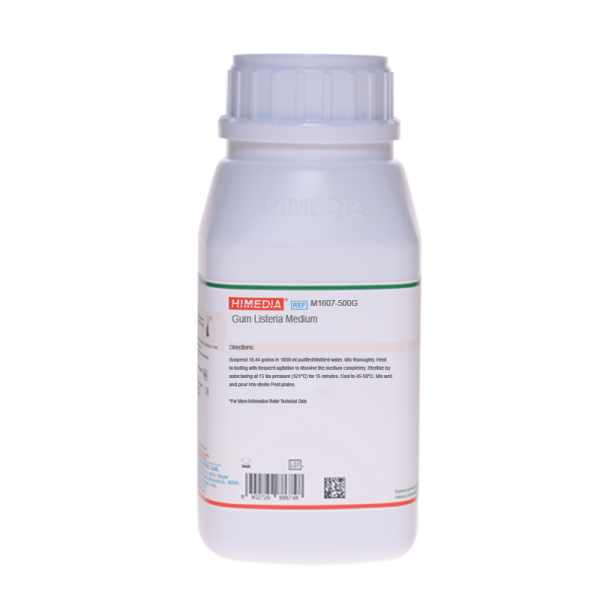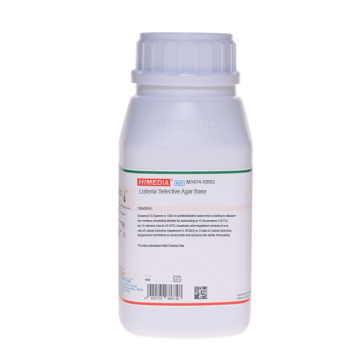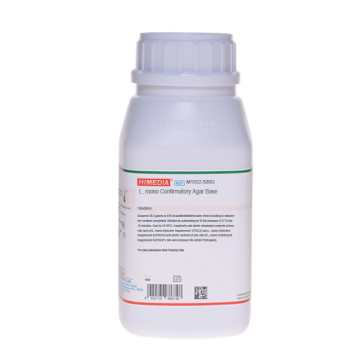 Your enquiry has been submitted
Your enquiry has been submitted
Gum Listeria Medium
Intended Use
Recommended for the isolation of Listeria monocytogenes from clinical and non-clinical specimens.
Composition**
| Ingredients | g/ L |
|---|---|
| Tryptone | 5.700 |
| Soya peptone | 1.000 |
| Dextrose (Glucose) | 0.830 |
| Sodium chloride | 1.700 |
| Dipotassium hydrogen phosphate | 0.830 |
| Magnesium chloride | 0.330 |
| Nalidixic acid | 0.050 |
| Gellan gum | 8.000 |
Final pH ( at 25°C): 7.2±0.2
**Formula adjusted, standardized to suit performance parameters
Directions
Suspend 18.44 grams in 1000 ml purified / distilled water. Mix thoroughly. Heat to boiling with frequent agitation to dissolve the medium. Sterilize by autoclaving at 15 lbs pressure (121°C) for 15 minutes. Cool to 45-50°C. Mix well and pour into sterile Petri plates.
Principle And Interpretation
Many media with agar have been developed to isolate and cultivate Listeria monocytogenes. But when the colonies are observed by special optical illumination, due to opaqueness of agar there is interference in the colour and characteristics of the colonies. Hence Martin et al (1) experimented with various formulations and found replacing the agar with self-gelling gellan gum (2) resulted in the formation of a transparent medium. This helped in colonial visualization and identification of Listeria using Henrys Oblique Light System (3). The Henrys oblique light system consists of a 6-volt lamp projected onto a concave mirror to the underside of the stage of a stereomicroscope at 45° angle, which provides the transmitted oblique light. The medium contains tryptone and soya peptone, which act as the nitrogen and carbon source. Dextrose is an energy source. Sodium chloride and magnesium chloride salt provide essential ions. Dipotassium phosphate provides buffering to the medium. Nalidixic acid inhibits gram-negative bacteria. Gellan gum, a solidifying agent provides more transparency to the medium than agar.
Type of specimen
Clinical samples and Dairy samples.
Specimen Collection and Handling
For clinical samples follow appropriate techniques for handling specimens as per established guidelines (6,7). For dairy samples, follow appropriate techniques for sample collection and processing as per guidelines (4,5). After use, contaminated materials must be sterilized by autoclaving before discarding.
Warning and Precautions
In Vitro diagnostic Use. For professional use only. Read the label before opening the container. Wear protective gloves/ protective clothing/eye protection/ face protection. Follow good microbiological lab practices while handling specimens and culture. Standard precautions as per established guidelines should be followed while handling clinical specimens. Safety guidelines may be referred in individual safety data sheets.
Limitations
- Further biochemical and serological tests must be carried out for further identification.
Performance and Evaluation
Performance of the medium is expected when used as per the direction on the label within the expiry period when stored at recommended temperature.
Quality Control
Appearance: Cream to yellow homogeneous free flowing powder
Gelling: Firm, comparable with 0.8% Gellan gum
Colour and Clarity of prepared medium: Pale to light yellow coloured, opalescent gel forms in Petri plates
Reaction: Reaction of 1.84% w/v aqueous solution at 25°C. pH : 7.2±0.2
pH: 7.00-7.40
Cultural Response: Cultural characteristics observed after an incubation at 35-37°C for 18- 24 hours.
| Organism | Inoculum (CFU) | Growth | Recovery |
|---|---|---|---|
| Escherichia coli ATCC 25922 (00013*) | 50-100 | none-poor | <=10% |
| Listeria monocytogenes ATCC 19112 | 50-100 | good | 40-50% |
Key : *Corresponding WDCM numbers.
Storage and Shelf Life
Store between 10-30°C in a tightly closed container and the prepared medium at 2-8°C. Use before expiry date on the label. On opening, product should be properly stored dry, after tightly capping the bottle in order to prevent lump formation due to the hygroscopic nature of the product. Improper storage of the product may lead to lump formation. Store in dry ventilated area protected from extremes of temperature and sources of ignition. Seal the container tightly after use. Product performance is best if used within stated expiry period.
Disposal
User must ensure safe disposal by autoclaving and/or incineration of used or unusable preparations of this product. Follow established laboratory procedures in disposing of infectious materials and material that comes into contact with clinical sample must be decontaminated and disposed of in accordance with current laboratory techniques (6,7).
Reference
- Martin R. S., Sumarah R. K. and MacDonald M. A., 1984, Clin. Invest. Med., 7:233.
- Shungu D., Valiant M., Tutlane V., Weisberg E., Wessberger B., Koupal L., Gadebusch H. and Stapley E, 1983, Appl. Env. Microbiol., 46:840.
- Henry, 1933, J. Infect. Dis., 52:374.
- Wehr H. M. and Frank J. H., 2004, Standard Methods for the Microbiological Examination of Dairy Products, 17th Ed.,APHA Inc., Washington, D.C.
- American Public Health Association, Standard Methods for the Examination of Dairy Products, 1978, 14th Ed.,Washington D.C.
- Isenberg, H.D. Clinical Microbiology Procedures Handbook 2nd Edition
- Jorgensen, J.H., Pfaller, M.A., Carroll, K.C., Funke, G., Landry, M.L., Richter, S.S and Warnock., D.W. (2015) Manual of Clinical Microbiology, 11th Edition. Vol. 1.
| Product Name | Gum Listeria Medium |
|---|---|
| SKU | M1607 |
| Product Type | Regular |
| Physical Form | Powder |
| Origin | Animal |
| Packaging type | HDPE |
| References | 1.Martin R. S., Sumarah R. K. and MacDonald M. A., 1984, Clin. Invest. Med., 7:233.2.Shungu D., Valiant M., Tutlane V., Weisberg E., Wessberger B., Koupal L., Gadebusch H. and Stapley E, 1983, Appl. Env.Microbiol., 46:840.3.Henry, 1933, J. Infect. Dis., 52:374. |
| Customized Product Available | No |








